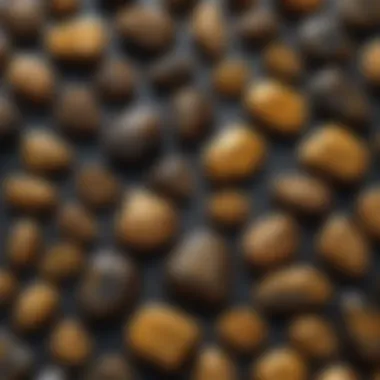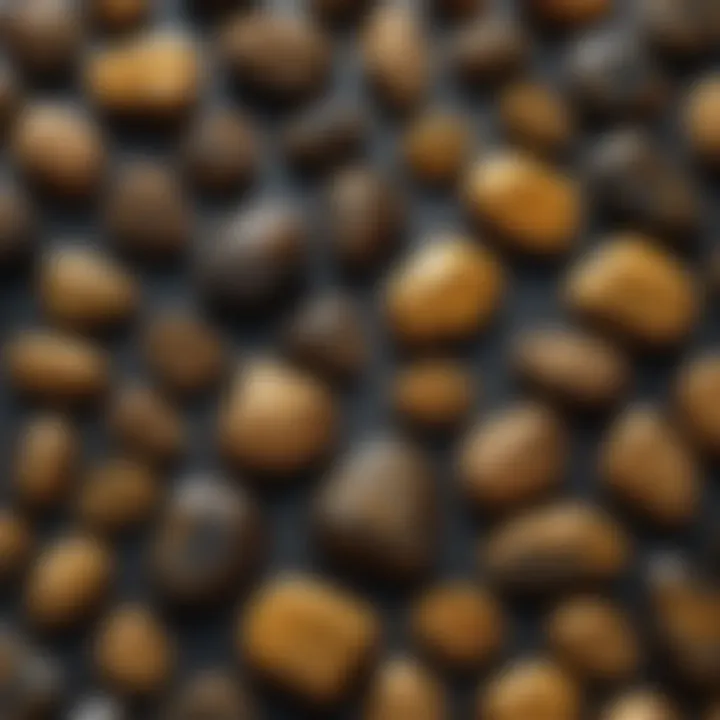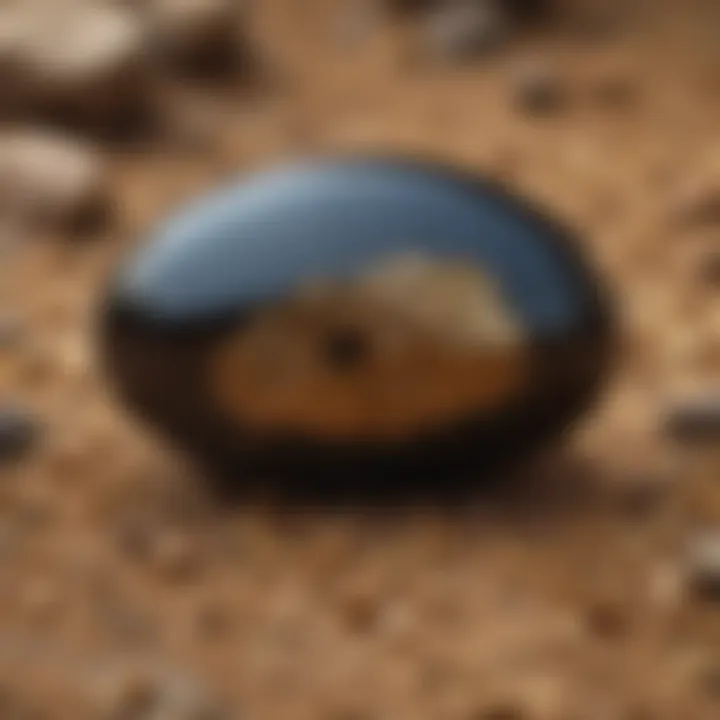Libyan Gold Tektite: An In-Depth Exploration


Featured Collectible of the Month
Overview
Libyan gold tektite, often referred to as Libyan Desert Glass, is a unique natural glass formed from the impact of meteorites. It is predominantly found in the Libyan Desert, making it a fascinating subject for collectors and a topic of geological study. This distinctive material boasts a translucent, golden hue, which is not only attractive but also possesses significant historical context.
Collectors value Libyan gold tektite both for its beauty and its scientific importance. Its rarity and the conditions of its formation make it a key piece in both personal collections and museum displays. Understanding Libyan gold tektite deepens appreciation for both natural phenomena and human history intertwined with these striking geological features.
Historical Significance
The history of Libyan gold tektite stretches back thousands of years. Ancient Egyptians utilized this material for ornamentation and tools. Archaeological finds suggest that it played a role in the culture of the time. Notably, it has been found associated with burial sites, indicating its perceived value. This product of cosmic events has transcended time, making it a collector's dream.
It has also captivated modern geological research. Researchers continually study its origin and formation processes, revealing insights into meteorite impacts on Earth. The study of Libyan gold tektite may provide fundamental clues about the geological past of our planet and, by extension, the universe.
"Libyan gold tektite not only embodies natural beauty, but also serves as a record of cosmic events that have shaped our planet's history."
Identification Techniques
Visual Characteristics
Identifying Libyan gold tektite involves several visual cues. Its most defining feature is its color, which ranges from pale yellow to rich amber. The texture is often smooth and glass-like, with slight variations. Often, tektites show unique inclusions or bubbles that can assist in identification. An irregular surface is common, and the pieces may vary in size, from small grains to larger chunks. Collectors should pay attention to these characteristics to differentiate it from other materials.
Resources for Identification
For those seeking to further their understanding of Libyan gold tektite, several resources exist:
- Wikipedia: Libyan Desert Glass
- Britannica on Tektites
- Online forums like Reddit and Facebook offer community insights and personal experiences.
By utilizing these resources, both novice and experienced collectors can enhance their skills in identification, improving their overall appreciation for this remarkable collectible.
Preface to Libyan Gold Tektite
The Libyan gold tektite holds a significant place in the realm of geological studies and collectibles. Its unique characteristics and origins captivate both scholars and enthusiasts alike. Understanding this material allows collectors to appreciate its geological narrative and cultural connections, particularly in ancient civilizations.
Definition and Overview
Libyan gold tektite is a form of natural glass that is believed to have formed due to the intense heat and pressure resulting from meteorite impacts. This tektite is primarily found in the Libyan desert, a vast area known for its harsh conditions and striking landscapes. The material is characterized by its distinctive golden color, which can range from light yellow to deeper amber hues. The properties of Libyan gold tektite make it not only an interesting geological specimen but also a sought-after item among collectors.
The composition of this tektite primarily includes silica, along with traces of other elements, which contribute to its unique appearance and properties. Collectors value Libyan gold tektite for its rarity and the beauty it adds to any collection. Moreover, the geological processes that led to its formation illuminate aspects of planetary history and natural phenomena.
Distinction from Other Tektites
Libyan gold tektite is distinct from other tektite varieties, such as Moldavite or Indochinite, primarily due to its origin and specific formation process. While many tektites form from similar impact events, the unique geographical and geological context of the Libyan desert contributes to the exceptional properties of Libyan gold tektite. Unlike Moldavite, which has a green hue due to its unique formation in the context of the Bohemian region, the gold color of Libyan tektite differentiates it in visual terms.
Moreover, the size and shape of Libyan gold tektites can also vary significantly. This variety provides collectors with numerous options and aesthetic appeal. As a result, understanding its distinct features becomes essential for accurate identification and valuation.
"Libyan gold tektite is likened to a natural time capsule that offers insights into both cosmic events and ancient human cultures."
Geological Background
Understanding the geological background of Libyan Gold Tektite is essential for grasping its significance within the context of Earth's history. This section will delve into the formation processes and the impact events that contributed to the genesis of this unique material. By exploring these facets, we aim to illustrate the broader relevance of Libyan Gold Tektite to both geological sciences and the collection community.
Formation Processes
The formation of Libyan Gold Tektite is tied closely to specific geological phenomena. It is believed that these tektites formed during major impact events. During these events, a collision between a meteorite and the Earth can generate intense heat and pressure. This extreme environment results in the melting and ejection of terrestrial material into the atmosphere. The cooling of these molten fragments then leads to the creation of distinct glassy materials, known as tektites.
Libyan Gold Tektite specifically emerged from an event that likely occurred around 28 million years ago in the region that is now the Sahara Desert. The precise location, along with the conditions surrounding this impact, played a crucial role in the subsequent formation of these tektites. Research suggests that the unique color and appearance of Libyan Gold Tektite stem, in part, from the particular silica content in the source material and local geological conditions. Understanding these processes is not just an academic exercise; they provide insight into the dynamics of impact geology and the evolution of the Earth's surface.
Impact Events and Tektite Formation
Impact events are pivotal to the study of tektites, as they serve as catalysts for the transformation of ordinary terrestrial material into extraordinary glass. The process begins with a significant asteroid or comet striking the Earth with enormous force. In the case of Libyan Gold Tektite, the impact site is believed to be in the region of the Great Sand Sea in Libya. Such collisions are not frequent but can produce vast amounts of debris scattered over large areas.


When the heat generated by the impact exceeds the melting point of the surrounding rocks, it vaporizes the material, creating a plume of molten rock. As this material is blasted into the high atmosphere, it cools and solidifies into glassy forms, which are then left scattered over the landscape.
It is essential to note that not all tektites share the same origins. The variations in material composition, color, and form can be attributed to different impact events across the globe. The Libyan Gold Tektite stands out for its distinctive gold hue, which is a result of its geological history and environmental conditions at the time of formation. This connection between celestial events and terrestrial materials underscores the importance of studying tektites: they are not mere geological curiosities, but rather fragments of Earth's history shaped by cosmic forces.
Key Point: The study of Libyan Gold Tektite enriches our understanding of impact events, showcasing the interplay between celestial phenomena and terrestrial geology.
In summary, the geological background of Libyan Gold Tektite serves as a foundation for comprehending its unique properties and cultural significance. By examining formation processes and impact events, we see this material as a product of Earth's dynamic history, making it an intriguing subject for both scientific inquiry and personal collection.
Physical and Chemical Properties
Understanding the physical and chemical properties of Libyan gold tektite provides crucial insights into its value as a collectible and its applications in various fields. These properties not only define the beauty and uniqueness of the material but also establish its significance in scientific research and cultural contexts. In this section, we will delve into two primary aspects: color, texture, and overall appearance; and composition and crystal structure.
Color, Texture, and Overall Appearance
Libyan gold tektite exhibits a distinct golden-yellow to amber color, which is one of its most recognizable characteristics. This hue comes from its high silica content and the way it interacts with light. The surface texture can vary, ranging from smooth to slightly pitted, often with a glassy finish. Collectors and enthusiasts appreciate these variations as they contribute to the unique charm of each specimen.
The overall appearance of Libyan gold tektite can include a variety of patterns and inclusions. These features can further indicate the tektite's origin and history, implying its journey through the atmosphere during formation. Such attributes play an essential role in valuing the piece in the market.
"The genuine allure of Libyan gold tektite lies in its striking appearance, making it a sought-after specimen among collectors."
Factors like location and environment during formation can affect its physical attributes, influencing its desirability. For collectors, recognizing these features is vital for identifying authentic pieces and understanding their unique history.
Composition and Crystal Structure
The composition of Libyan gold tektite primarily involves silicon dioxide ( SiO2 the primary component), alongside trace elements such as aluminum and iron - this contributes not only to its color but also to its texture. Understanding its chemical makeup is vital for someone looking to explore its properties more deeply.
The structure of Libyan gold tektite is predominantly amorphous, which means it lacks a regular crystal structure. This distinguishes it from many traditional gemstones and mineral specimens. While most minerals crystallize into well-defined structures, tektites do not exhibit such uniformity due to their unique formation process involving rapid cooling after an impact event.
The amorphous nature of Libyan gold tektite enhances its appeal, since it carries scientific intrigue about its formation and versatility for various applications. Additionally, the lack of crystalline formation makes it more resistant to weathering and physical damage, an important consideration for collectors looking to maintain their specimens for extended periods.
In summary, the physical and chemical properties of Libyan gold tektite unite aesthetics with scientific inquiry, thus deepening both its collectible value and its relevance in geological studies.
Historical Context and Cultural Significance
The historical context and cultural significance of Libyan gold tektite is rich and layered. Understanding its relevance goes beyond mere geological perspectives. It offers insight into ancient civilizations, their beliefs, and how natural elements shaped their lives. This section will elucidate the importance of Libyan gold tektite in both historical settings and modern contexts.
Ancient Uses and Beliefs
Libyan gold tektite was revered by ancient cultures for its distinctive appearance and properties. Its striking golden hue often inspired various myths and beliefs. Many societies viewed it as a talisman, linking its otherworldly origins to divine favor or protection. Archeological findings suggest that it was used in rituals and as ornaments, representing both status and cultural identity.
In ancient times, people believed that the stone held power. It was thought to bring good luck and protect against misfortune. Artifacts made from Libyan gold tektite have been found in burial sites, indicating its significance in funerary practices. This use highlights its dual role as both a valuable object and a spiritual symbol. The presence of this material in ancient relics illustrates a connection to the earth and cosmos, demonstrating how early humans sought to find meaning in the natural world.
Many collectors and enthusiasts today seek out Libyan gold tektite not just for its aesthetic appeal but also for its historical value. Items that carry this tektite often come with stories, linking them back to ancient beliefs and usages, making each piece unique.
The Role of Libyan Gold Tektite in Egyptian Culture
In Egyptian culture, Libyan gold tektite assumed particular significance. The geographical proximity of the Libyan Desert meant that ancient Egyptians encountered this material frequently. They were known to have crafted jewelry and ceremonial artifacts from it. The natural beauty of Libyan gold tektite complemented the ornate designs prevalent in ancient Egyptian art.
Archaeological evidence indicates that Libyan gold tektite was integrated into the jewelry of pharaohs. It symbolized both wealth and influence, often believed to confer powers of protection. The stone's rarity added to its cultural capital. When Europeans began to explore ancient Egyptian tombs, they noted the presence of Libyan gold tektite in artifacts, further cementing their fascination with its historical importance.
Moreover, the impact of Libyan gold tektite has extended beyond mere artifacts. The emotional and spiritual connections that ancient Egyptians formed with this material reflect a broader understanding of the environment's role in human culture. As a resource, it served as a bridge between the natural and the divine, a concept still valued among modern collectors and researchers.
"The significance of Libyan gold tektite transcends its physical properties; it embodies a historical narrative that continues to inspire collectors and scholars alike."
Collecting Libyan Gold Tektite
Collecting Libyan gold tektite attracts many enthusiasts and serious collectors due to its unique properties and cultural significance. The allure of this material extends beyond its physical characteristics, as it offers a connection to ancient geological events. For collectors, understanding the nuances of Libyan gold tektite is crucial for making informed purchases and appreciating its value.
Identifying Authentic Pieces
Authenticity plays a pivotal role in the value of any collectible. When it comes to Libyan gold tektite, it is essential to verify that a piece is genuine. Here are some methods for identifying authentic pieces:


- Look for the characteristic color: Libyan gold tektite typically showcases a golden to greenish hue. This color results from specific compositional elements present in the glass.
- Examine the texture: Authentic pieces often have a unique surface texture. They can be smooth yet display tiny patterns or markings indicative of their formation process.
- Consider the weight: Tektite is denser than many other materials. Therefore, a piece that feels unusually light may not be authentic.
- Seek expert evaluation: When in doubt, it is advisable to consult with a geologist or a gemologist who specializes in tektites. These experts can provide insights into a piece's authenticity.
Taking these steps ensures that collectors build a genuine collection that holds its value over time.
Market Trends and Valuation
The market trends surrounding Libyan gold tektite reveal much about its desirability. Prices fluctuate based on various factors, including availability, demand, and current interest in tektite collecting. Here are key elements impacting market trends:
- Scarcity and Availability: As with any collectible, scarcity increases value. Since Libyan gold tektite is not as commonly found as other materials, it is often priced higher.
- Condition and Quality: Pieces in pristine condition command better prices than those with visible wear or damage. Collectors are often willing to pay a premium for rare high-quality specimens.
- Recent Sales Trends: Keeping track of previous auction results and sales in specialized marketplaces can provide collectors with insight into current valuation trends.
Understanding these factors empowers collectors to make informed decisions regarding their investments in Libyan gold tektite. By focusing on authenticity and remaining aware of market influences, enthusiasts can better navigate the complexities of this unique collectible.
Care and Preservation Techniques
Caring for Libyan Gold Tektite is crucial for collectors who wish to maintain the integrity and appearance of these unique specimens. Proper care and preservation not only enhance their durability but also protect their aesthetic value. As naturally formed objects, their composition can be sensitive to environmental factors. For collectors, understanding care techniques can lead to a longer-lasting and more valuable collection.
Suitable Storage Methods
When it comes to storing Libyan Gold Tektite, selecting the right environment is vital. Here are key considerations:
- Controlled Temperature: Maintain a stable temperature as excessive heat or cold can alter the properties of the tektite.
- Low Humidity: Store in low humidity areas to prevent moisture damage. High humidity can lead to mold or other degradation.
- Soft Lining: Use soft materials like felt or velvet in storage containers to reduce scratches or damage to the surface.
- Use of Display Cases: Opting for display cases that protect from UV light will help in maintaining color and texture over time.
- Avoid Direct Sunlight: Prolonged exposure to direct sunlight can fade or alter the appearance of Libyan Gold Tektite.
These methods not only protect the material but also present the pieces attractively for display. Incorporating suitable storage methods reflects careful consideration to preserve the natural beauty of Libyan Gold Tektite.
Cleaning and Maintenance Guidelines
Keeping Libyan Gold Tektite clean enhances not just its appearance but also prevents potential damage from contaminants. Here are some established guidelines:
- Gentle Cleaning: Use a soft, dry cloth to gently wipe the surface. Avoid abrasive materials that could scratch.
- Avoid Chemicals: Refrain from using harsh chemicals or solutions. They can react with the mineral composition leading to irreparable damage.
- Use Mild Soap: If necessary, a mixture of mild soap and water can be used. Dampen the cloth with the solution rather than soaking the specimen directly.
- Pat Dry: After cleaning, always pat the specimen dry with a clean, soft cloth. Ensure it is completely dry before storing again.
- Regular Checks: Regularly examine stored pieces for dust build-up or any signs of deterioration.
By following these cleaning and maintenance guidelines, collectors can ensure their Libyan Gold Tektite remains visually stunning and preserves its historical and geological significance.
"Proper care and preservation of Libyan Gold Tektite not only prolongs its life but enhances its collectible value for generations."
In summary, the methods of care and preservation are essential for any serious collector or enthusiast of Libyan Gold Tektite. Ensuring optimal storage and following cleaning protocols directly influences the longevity and appreciation of these remarkable natural wonders.
Scientific Studies and Research
Scientific studies on Libyan gold tektite are vital to understand its unique formation, properties, and significance in natural science. These studies provide insight into the historical events that led to the creation of tektites, as well as their chemical and physical characteristics. Understanding these factors not only enhances our knowledge of this specific material but also contributes to broader fields such as geology, planetary science, and archaeology.
Recent Discoveries
Recently, scientists have uncovered intriguing findings related to Libyan gold tektite. One notable discovery is the evidence supporting its origin from high-energy impact events. Advanced techniques, including electron microscopy and isotopic analysis, have helped to confirm that Libyan gold tektite is a result of impacts that occurred approximately 29 million years ago.
Another fascinating aspect is the ongoing research into the potential extraterrestrial influences on its formation. Some studies suggest that the high silica content and certain trace elements found in Libyan gold tektite align with materials sourced from meteorite impacts. This connection fuels further investigations into the cosmic events that shape terrestrial materials, leading to new questions about how such occurrences result in unique geological formations.
Additionally, ongoing archaeological studies have aimed to reveal how ancient civilizations utilized Libyan gold tektite. These investigations spotlight the material's historical significance, extending beyond just geological interest to encompass cultural heritage.
Tektite Research and Ongoing Projects
Various research teams are currently engaged in projects exploring Libyan gold tektite and other tektites across the globe. One area of focus is the synthesis of tektite-like materials in laboratory settings. Creating artificial analogs aims to mirror the conditions under which natural tektites form. Researchers are interested in how these synthetic materials can offer insights into planet formation and the processes surrounding meteor impacts.
Modern analytical techniques, including spectrum analysis and chemical characterization, provide a comprehensive framework for these projects. The results not only inform scientific understanding of Libyan gold tektite but also aid in developing practical applications. For instance, the material's unique properties might hold potential for varied applications in technology and industry.
In summary, research projects focused on Libyan gold tektite offer essential perspectives into its origins and applications. Discoveries in this area contribute not only to the understanding of this specific tektite but also enrich the field of geology and beyond. Each finding sheds light on the intricate relationship between cosmic events and terrestrial materials, ultimately enhancing appreciation for the natural world's complexities.
Libyan Gold Tektite and Modern Applications
The significance of Libyan Gold Tektite in modern applications cannot be understated. This unique material, born from meteorite impacts, has found its way into various industries thanks to its distinctive properties. From industrial uses to decorative applications, the versatility of Libyan Gold Tektite is noteworthy.
Industrial and Technological Uses


Libyan Gold Tektite serves several practical applications. Its high silica content makes it valuable in some manufacturing processes. Companies involved in ceramics and glass production value its properties, as it can improve the strength and appearance of their products.
Moreover, research and development teams utilize Libyan Gold Tektite in scientific studies to better understand its formation and impact processes. It acts as a tool for geological research, aiding scientists in unraveling the mysteries of our planet's history. Some cosmetic companies have even begun incorporating small amounts of powdered Libyan Gold Tektite into their formulations, promoting its purported regenerative capabilities.
Key applications include:
- Strengthening materials in construction
- Enhancing glass clarity and durability
- Serving as a teaching tool in geology classes
These uses indicate a trend where Libyan Gold Tektite bridges the gap between nature and technology.
Jewelry and Decorative Items
As a material for jewelry and decorative items, Libyan Gold Tektite is sought after by collectors and enthusiasts. Its striking color and unique texture make it a popular choice for rings, necklaces, and bracelets. Jewelers appreciate its aesthetic appeal, which provides an organic touch to modern designs.
Incorporating Libyan Gold Tektite into jewelry not only elevates the style but also adds a story behind each piece. Many wearers value the historical and cosmic significance that this tektite carries, deriving a sense of connection with the Earth’s past.
When discussing jewelry, important details include:
- The weight and size of the tektite can influence its market value.
- Unique shapes and designs get greater attention in the market.
- Care must be taken to maintain its surface and sheen, as proper cleaning methods help preserve its beauty.
Comparative Analysis with Other Natural Materials
The comparison of Libyan gold tektite with other natural materials is essential. This section serves not only to highlight the unique characteristics of Libyan gold tektite but also to place it within a broader context of tektites and other geological specimens. Understanding these comparisons helps collectors discern quality, value, and the scientific relevance of this intriguing material.
Comparison with Moldavite and Other Tektites
Libyan gold tektite shares similarities with other tektites, such as Moldavite and Indochinite, yet it is distinguished by specific attributes. Moldavite, for instance, is largely recognized for its vivid green color and glassy texture. It formed from the impact of a meteorite in what is now the Czech Republic.
Conversely, Libyan gold tektite is characterized by its striking golden hue, a result of its unique formation in the Libyan Desert. Its origin stems from a different impact event, believed to be over 29 million years ago. While both Moldavite and Libyan gold tektite are valued in the collector community, their origins and physical forms set them apart significantly.
In terms of mineral composition, Moldavite typically contains a higher concentration of silicon dioxide, giving it its characteristic hardness and durability.
"Libyan gold tektite is valued for its rarity and distinct golden color, making it a sought-after item among collectors."
It is also worth noting that the market demand varies considerably between these materials. Moldavite has gained a cult following, often attracting higher prices due to its aesthetic appeal and the lore surrounding it. On other hand, Libyan gold tektite, while less well-known, has a niche group of dedicated collectors interested in its historical and geological significance.
Differences in Properties and Origins
The properties of Libyan gold tektite and other natural materials vary extensively. For instance, Libyan gold tektite is less dense than Moldavite but is still hard enough to be durable. The color differentiation is a major point of distinction as well; the shimmering golden tones of Libyan gold tektite contrast sharply with the deep greens of Moldavite.
Additionally, the origins of these materials influence their scientific study. Research has revealed that Libyan gold tektite crystallized under different conditions compared to other tektites from diverse regions. The environmental conditions, including the temperature and pressure at the time of formation, lead to distinct characteristics in the crystal structure.
When comparing Libyan gold tektite with other natural materials, such as obsidian or other volcanic glasses, it becomes evident that tektites have a unique formation process tied to cosmic impact. This highlights a fascinating interplay between extraterrestrial forces and terrestrial materials. Collectors should recognize these differences as not merely aesthetic but as indicators of the geological history embedded within these specimens.
In summary, the comparative analysis of Libyan gold tektite with other natural materials enriches our understanding of its value, origins, and properties. This knowledge equips collectors with essential insights and promotes a deeper appreciation for the unique qualities of Libyan gold tektite.
Challenges in Collection and Research
The collection and research of Libyan Gold Tektite present several significant hurdles that need careful consideration. These challenges include regulatory frameworks, ethical collection practices, and the environmental consequences tied to removing specimens from their natural habitat. Understanding these elements is essential for responsible collectors and researchers alike, as it impacts both the sustainability of collecting practices and the preservation of this unique geological material.
Regulatory and Ethical Considerations
One of the foremost challenges in collecting Libyan Gold Tektite is navigating the regulatory landscape that governs its collection. Various laws dictate the legality of collecting tektites in certain regions. In the case of Libya, the political stability and consistent governance can influence these regulations, making it crucial for collectors to stay informed about current laws and find permissible methods for acquisition. Collectors must ensure that they are acquiring pieces legally, as violations could lead to severe penalties, including fines or confiscation.
Ethically, the responsibilities of collectors extend beyond just legality. Respecting local cultures and the sentiments surrounding Libyan Gold Tektite is equally important. For instance, many communities may have historical ties to these artifacts. Collectors should prioritize obtaining pieces from reputable sources and be aware of the potential for illicit trade. Being mindful of these ethical considerations contributes to the integrity of the collecting community and helps to foster positive relationships with local populations.
"Collecting Libyan Gold Tektite should be an act of admiration, not exploitation."
Conservation and Environmental Impact
Conservation poses another challenge that collectors and researchers must address. The extraction of Libyan Gold Tektite from its natural setting can have considerable environmental effects. The areas where these tektites are found may not only be ecologically sensitive but also crucial to local biodiversity. Disturbing these sites can lead to habitat destruction and adversely affect local species.
To mitigate these environmental impacts, collectors should adopt sustainable practices. This includes choosing to source specimens from locations that engage in responsible mining and avoid regions that see uncontrolled extraction activities. Research initiatives often stress the importance of preserving the natural environment while still allowing for collection and study, emphasizing that responsible practices can coordinate both scientific inquiry and ecological preservation.
Additionally, initiatives focusing on education and awareness are vital. By increasing understanding of the environmental issues associated with collecting, the community can foster a culture of responsible stewardship towards Libyan Gold Tektite and its original habitats.
In summary, while the allure of Libyan Gold Tektite may entice collectors and researchers, it is imperative to approach its collection with a strong ethical framework, regulatory awareness, and a commitment to environmental responsibility. These challenges, if addressed properly, not only enhance the integrity and sustainability of the field but also honor the historical and cultural significance of this extraordinary material.



